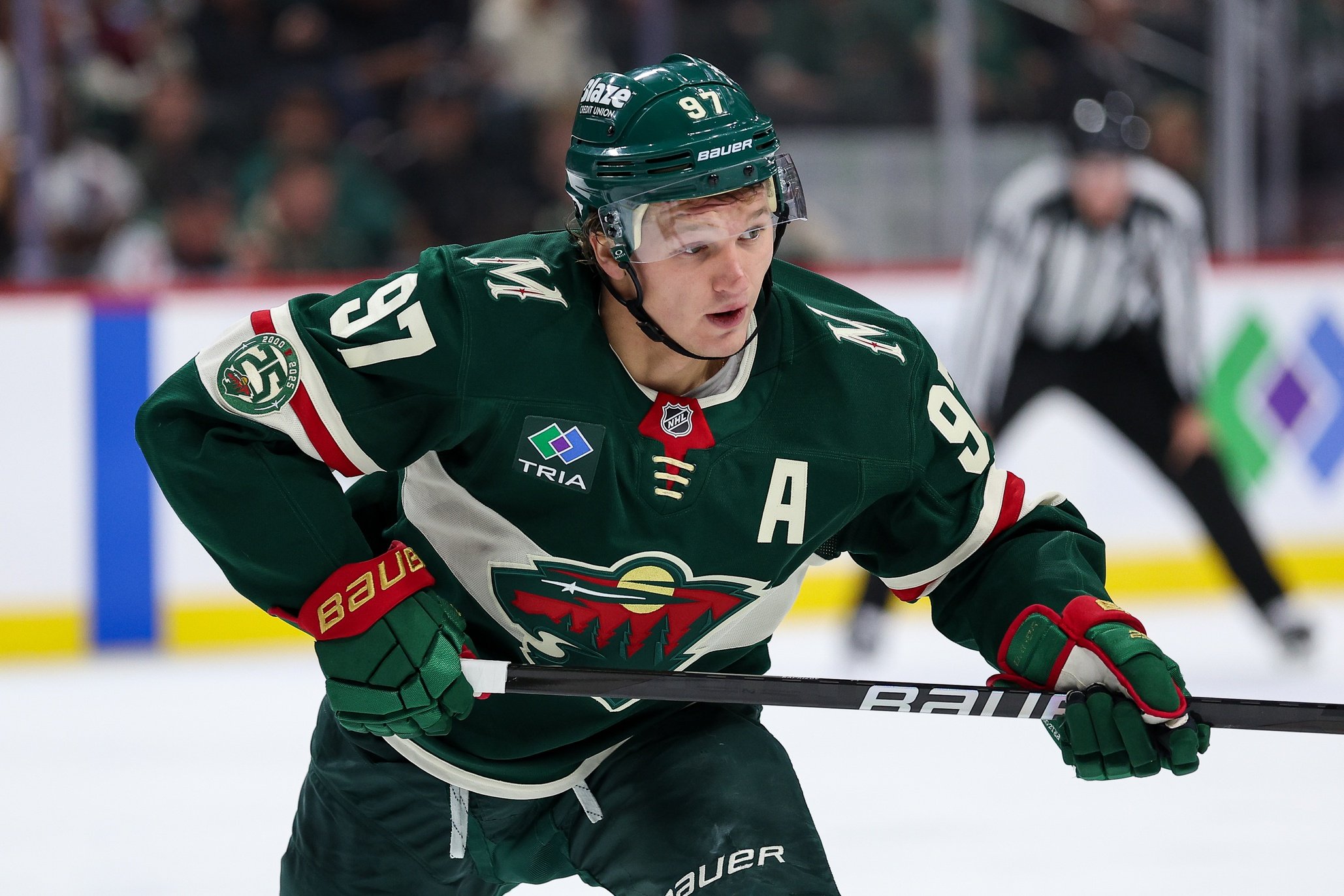
The State of Hockey has spent this week in jubilation over Kirill Kaprizov staying with the Minnesota Wild for the next nine years. The last time Wild fans had so much to celebrate from a signing was back in July 2012, when the team inked the infamous Ryan Suter and Zach Parise contracts.
Note how they're "infamous" now.
On Day 1, those contracts carried a poison pill: Their absurdly long term. By the end of the deal, Suter was 40 and playing a depth role with the St. Louis Blues, Parise was retired from hockey, and both had been bought out for four years. All of this was entirely predictable, even to the parties involved in signing the contract at the time. It was just a problem for a different general manager and a different decade of fans.
That's the NHL's version of The Winner's Curse. You're signing on to most free agents with the understanding that you're paying for production in the first few years, and the deal is probably going to look a lot worse in their final years. As Minnesotan philosopher Mitch Hedberg once said, "I'm not gonna stop doing something because of what happens at the end."
By the time Kaprizov's contract is over, it'll be the year 2034, and he will have just finished his age-36 season, turning 37 years old. Wild fans have seen old-timers produce, of course. Mats Zuccarello posted 54 points in his age-37 season last year, and Andrew Brunette even had a bit left in the tank at that age. However, we can point to numerous examples of things going wrong long before a player reaches that age.
Dany Heatley might be the ultimate example. The Wild traded for the two-time 50-goal scorer before his age-31 season, and he stepped into Minnesota's lineup and immediately scored... 24 goals and 53 points. It got worse from there, dropping to 21 points in just 36 games at 32, then a paltry 12 goals and 21 points in 76 games at 33.
When the bottom falls out on players, their production can collapse instantly. Jason Pominville went from 30 goals in his age-31 season to 18, then 11 over the following two years. Thomas Vanek was still productive on the power play during his age-31-and-32 campaigns in St. Paul, but was utterly unplayable in almost every other situation.
Wild fans have been burned by long-term (and even not-so-long-term, in the case of Heatley and Vanek) deals to aging stars going sour. Even so, it seems misguided to buy into fears that the Kaprizov deal will fall off so dramatically. Why is that?
For one, when you look at most of these players -- Parise, Suter, Vanek, and Pominville -- you'll see that they didn't have nearly as much room to fall as Kaprizov does. Kaprizov stands out as a cut above the rest in terms of sheer production and is among the elite of the elite when it comes to players over the last 20 seasons.
Points Per Game, Ages 23-27, Since 2005-06:
- Connor McDavid, 1.70
- Leon Draisaitl, 1.46
- Nathan MacKinnon, 1.36 (1.361)
- Sidney Crosby, 1.36 (1.355)
- Nikita Kucherov, 1.31
- Auston Matthews, 1.27
- Mitch Marner, 1.26
- David Pastrňák, 1.25
- Mikko Rantanen, 1.23
- Kirill Kaprizov, 1.21
All due respect to someone like Zach Parise, his output was "only" 0.93 points per game in that age span. When his play started dipping, he went from being a 62-point player (over an 82-game pace) in his first four years in Minnesota to being a 52-point player over his last five. Kaprizov is starting out as a 99-point player.
It'd be nice to see how these elite producers aged, but other than Sidney Crosby, none of the top-10 have really entered their mid-30s. Kucherov is the oldest of the remaining nine, and he's just 32 and still putting up MVP-type numbers.
The list being dominated so much by younger players reflects a bit of an offensive explosion in recent years. So let's take a look at the top-scoring players of Crosby's generation, and maybe a half-step behind them, looking at this same category from 2000-01 to 2015-16:
Points Per Game, Ages 23-27, 2000-01 to 2015-16:
- Sidney Crosby, 1.36
- Joe Thornton, 1.30
- Alex Ovechkin, 1.19 (1.194)
- Evgeni Malkin, 1.19 (1.188)
- Dany Heatley, 1.18
- Marián Gáborík, 1.11
- Patrick Kane, 1.06
- Jason Spezza, 1.05 (1.054)
- Vincent Lecavalier, 1.05 (1.052)
- Henrik Zetterberg, 1.04
Those were, more or less, the equivalents of Kaprizov and his peers from that generation. We know how all of their careers have played out through their age-36 seasons. So now let's look at how those players aged, looking at ages 28 through 32 (correlating to Kaprizov's final year of his deal, plus the first half of his extension), and ages 33 through 36 (correlating to the final half of Kaprizov's extension).
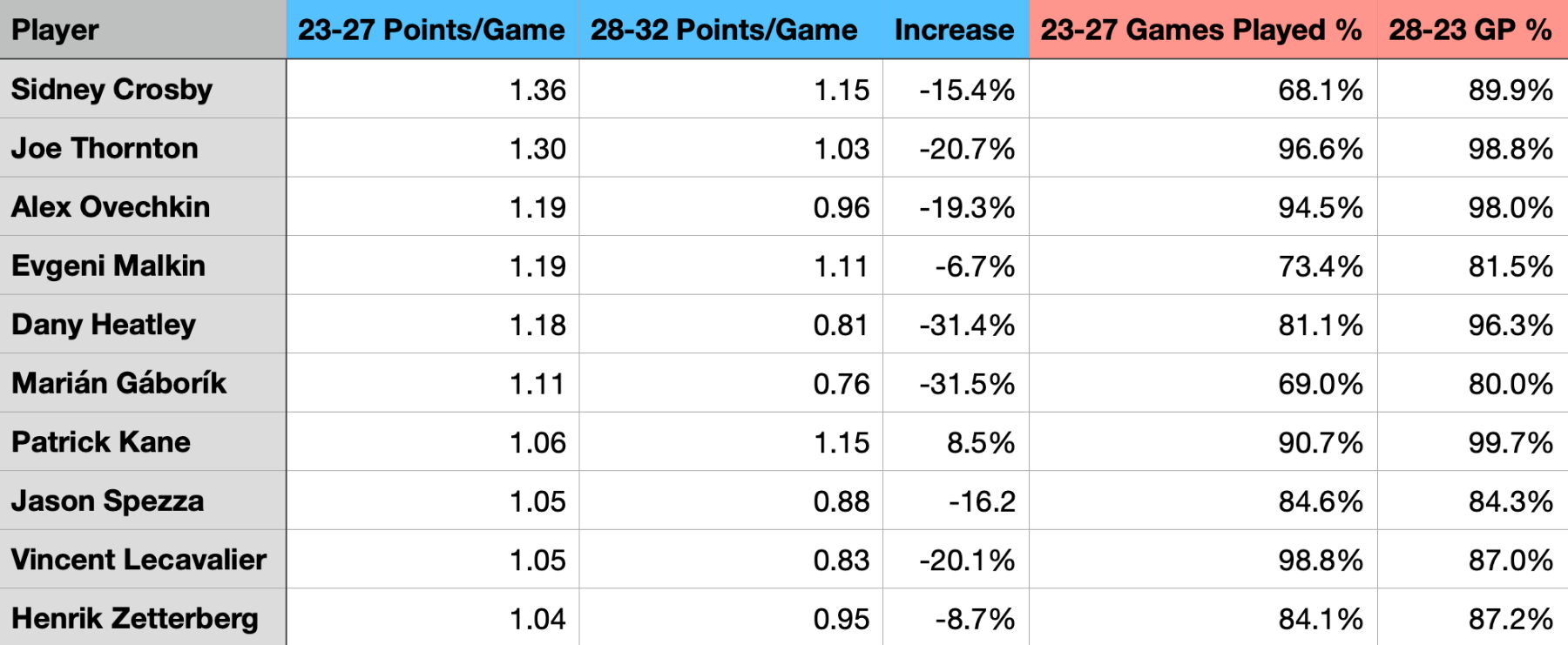
We see a few different paths, with Kane and Malkin having little-to-no dropoff, and Heatley and Gaborik falling off by almost a third. On the whole, however, the combined total of these ten players suggests an expected decrease of about 15.6% in points per game. If we apply that to Kaprizov, we can expect his 82-game pace to go from being a 99-point player to falling into the 84-point range. Perhaps not Hart Trophy-worthy, but over a point-per-game.
It's also interesting that most players on this list were often healthier in that age bracket than they had been before, though that might be a reflection of a small sample size.
As expected, the ages when Kaprizov will be in the back half of his deal are much rougher for these star players.
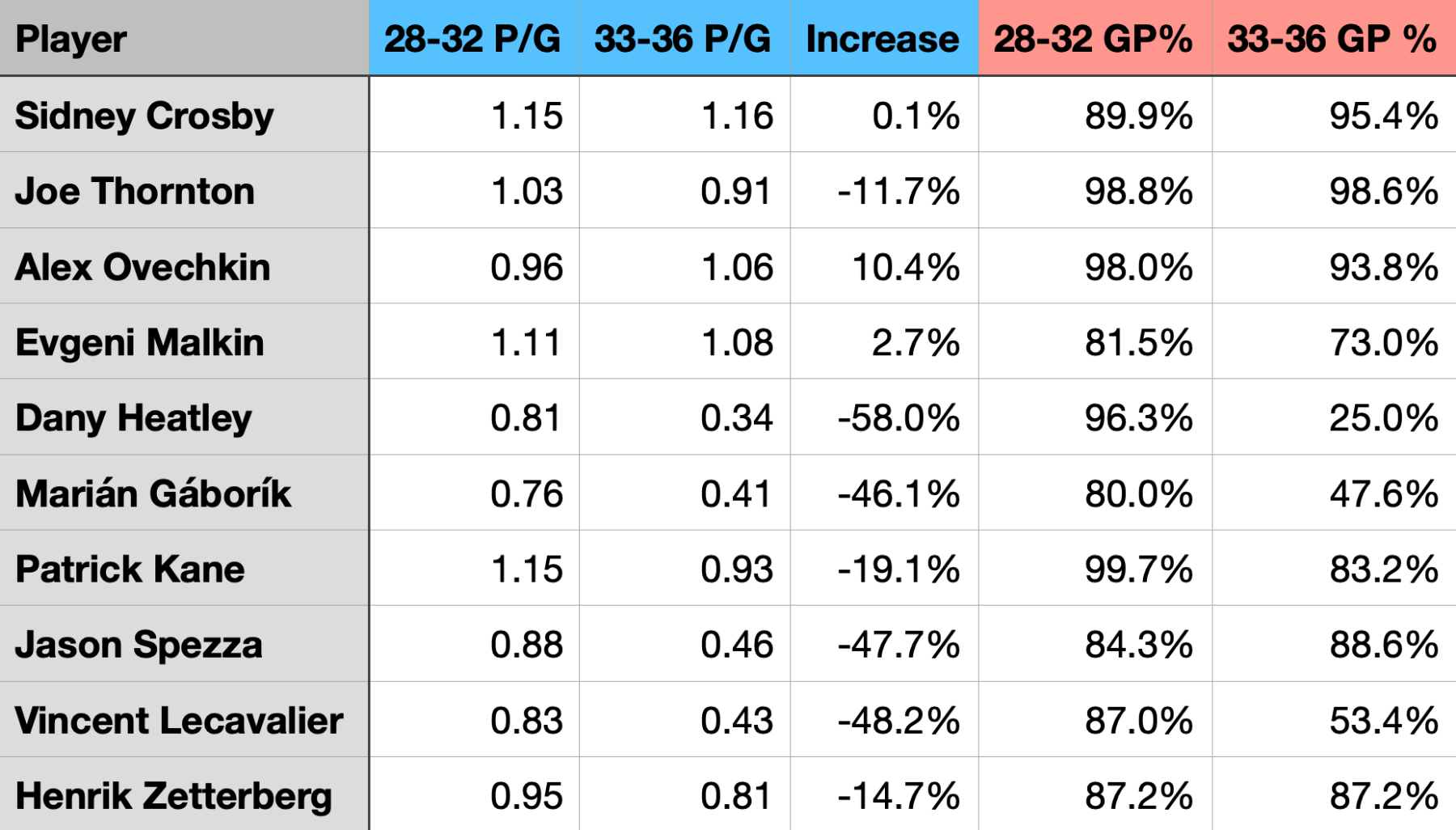
We can see massive drop-offs from four players on the list: Heatley, Gaborík, Spezza, and Lecavalier. Among those four, only Spezza remained in the league by age-36, and Heatley didn't even make it to his age-35 season.
Those are the worst-case scenarios, but when you look at the overall picture, the decline isn't quite as stark. The group's overall points per game only drops around 15.5%, nearly identical to the drop between their ages 23-27 production to 28-32. If we want to apply that to Kaprizov's 84-point expectation from ages 28 to 32, that translates to being a 71-point player.
You can probably account for the injury risk by assuming Kaprizov only plays 74% of the games (the average of everyone here), except that this really seems to be an all-or-nothing affair. Your body seems to either hold up or not. The only player on this list to play between 55 and 80% of their possible games from ages 33-to-36 is Malkin.
It's also worth noting that the players who've aged best throughout this time tend to be the ones with multiple ways of creating offense. You may have already suspected that, seeing as the biggest drops in offense from the prime years to ages 28-to-32 came from Heatley and Gaborík, two elite, but fairly one-dimensional goal-scorers. But look at the 10 most productive players from ages 33-to-36, and that trend becomes even clearer.
Points Per Game, Ages 33-to-36, since 2000-01:
- Daniel Alfredsson, 1.17
- Sidney Crosby, 1.16
- Martin St. Louis, 1.07
- Alex Ovechkin, 1.06
- Patrice Bergeron, 0.98
- Ray Whitney, 0.95
- Mats Zuccarello, 0.94
- Patrick Kane, 0.93
- Joe Thornton, 0.91
- Brad Marchand, 0.90
How many of those players would anyone say were one-dimensional? Ovechkin and his ageless one-timer? Granted, but he's a freak. Thornton with his vision? Maybe, although that feels like selling him short, given his exemplary defensive game. Everyone else on the list had multiple ways to generate offense in their primes (even Whitney and Zuccarello, whose numbers are probably influenced by being in the right place at the right time).
Kaprizov is an elite goal scorer, there's no doubt about that. His quick-twitch reflexes might slow down once he gets to his mid-30s, and he might not be a perennial 40-goal player anymore. But Kaprizov also has elite vision and hockey sense, and those don't age nearly as much. In fact, you can argue that they only get better with experience.
There is absolutely a risk in signing a player to a $17 million cap hit through their age-36 season. Nobody can deny that. However, there is a significant difference between watching a Hall of Very Good-type player like Parise, or a one-dimensional goal scorer like Heatley age, versus a truly elite, multifaceted offensive creator. If the Wild are going to make that big of a bet with anyone, Kaprizov feels like a very strong choice to bank on.
Think you could write a story like this? Hockey Wilderness wants you to develop your voice, find an audience, and we'll pay you to do it. Just fill out this form.
-
 2
2
-
 2
2

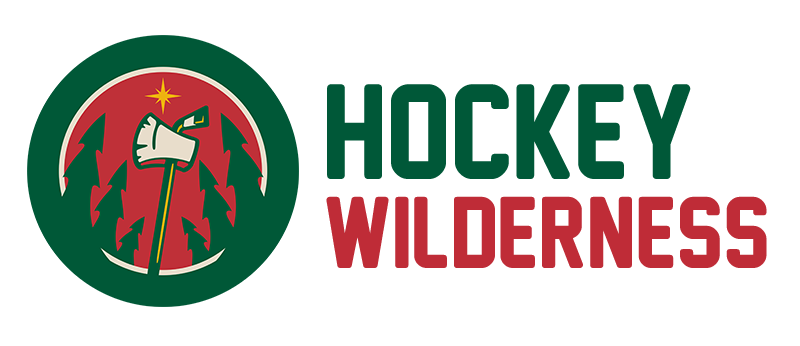



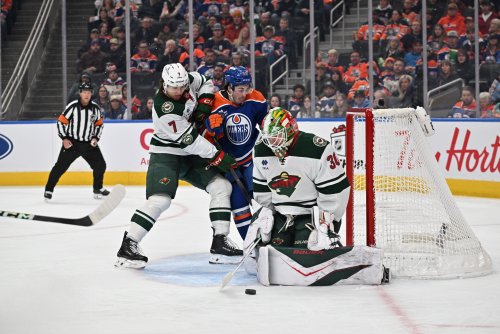



Recommended Comments
Join the conversation
You can post now and register later. If you have an account, sign in now to post with your account.
Note: Your post will require moderator approval before it will be visible.